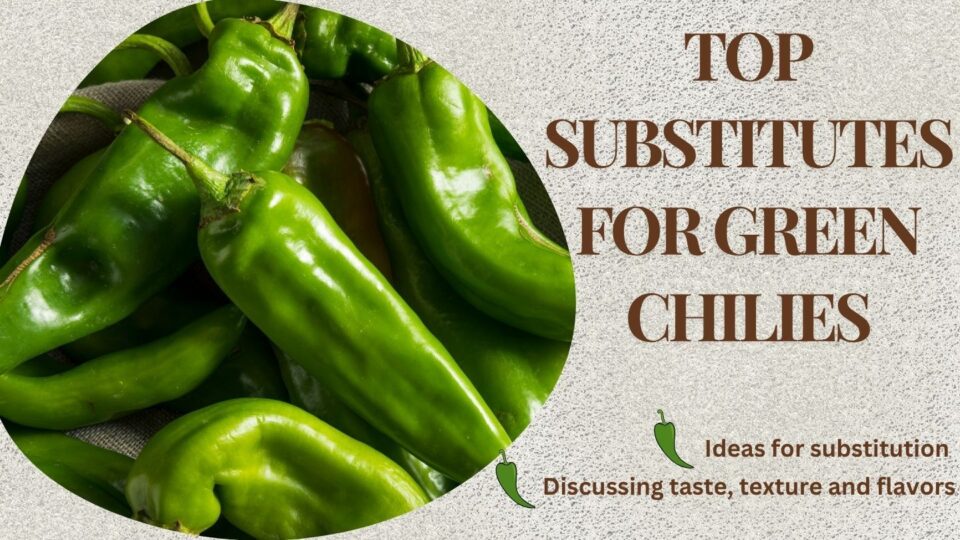Getting the right substitutes for green chilies can get quite complex – not because of availability because they’re available pretty much everywhere, but because what qualifies as a green chile varies significantly by region.
For most of us, the origins or type of green chile is rarely a question. It’s simply the chile you find in the store! However, the problem arises if there’s a need for a substitute. What could even qualify outside of the green chileI know from the store?
This is also somewhat relevant for the modern culinary world. Imagine seeing a wonderful recipe online or in a cookbook from a different country. You make it and the balance is off – perhaps because their definition of chile or green chile is different from the chile you see!
To be fair, this is less of a problem in the USA, and especially in the South and Southwestern USA. With the wide variety of peppers available, there is better labeling for individual peppers. Yet, it’s not absolute and there is room for some confusion.
So, with all these concerns in play for a green chile substitute, it’s only natural that we go a bit more into the details to make the right choice.
Conventionally, the top substitutes for green chilies are canned diced green chilies, hatch chile(green), green cayenne pepper, Indian green chile, serrano pepper, green Fresno pepper, poblano pepper, banana pepper, bell pepper, and green jalapeno pepper.
Since we’re on topic, let’s also discuss canned diced green chilies and possible no-nightshade green chile substitutes.
Table of Contents
Weighing The Best Substitutes For Green Chilies
1. Canned Diced Green Chilies
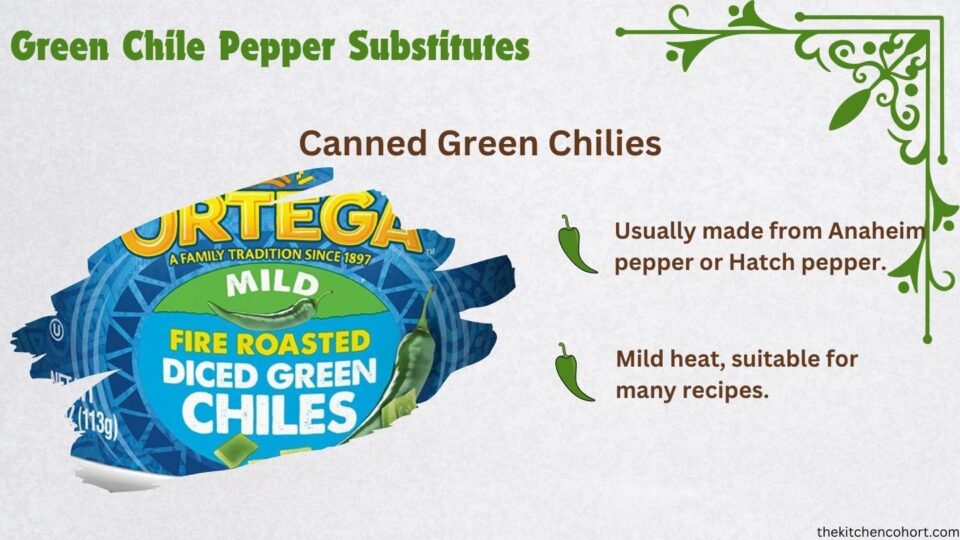
When in doubt, this commercial product is your way out! Canned diced green chilies are pretty easy to work with, are readily available, and can be substituted in a recipe for green chilies with ease.
Many recipes in fact simply call for a 4oz can of green chilies. Canned chile is usually made from roasted, peeled, and diced anaheim pepper or hatch pepper. The process also gives them a distinctive smoky and flavor, somewhat different from plain green pepper.
Many diced green chilies also lose their seeds during canning, which means they’re less spicy than the plain ingredient chilies. Most canned chile peppers are rated mild on the heat scale. However, of course, if you’re looking for something spicier, there’s a good chance you’ll find a product that fits your requirements!
2. Anaheim Peppers Or Hatch Green Chile
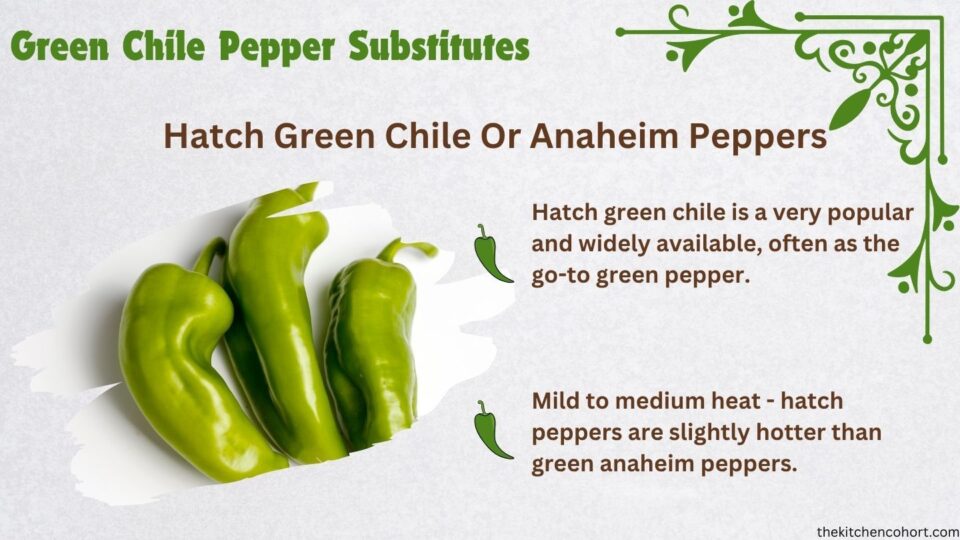
For a good portion of the USA, green anaheim peppers (also called California Chili) are exactly what we would usually call green chilies.
Hatch Green chile is a famed delicacy that’s very similar to anaheim peppers. In fact, anaheim peppers are a variant of New Mexico green chili. Hatch is a region in New Mexico famous for its pepper cultivation and quality.
Considering its fame, there is a bit of geographic importance attached to the region and the peppers grown there. According to New Mexico, only peppers growing within the region of Hatch can lay claim to that name. Hatch green chile is often
As green chile goes, conventional green anaheim peppers get a rating of mild to medium on the Scoville Heat Scale (SHU). The hatch green chile usually has a similar medium rating for SHU, but is generally hotter than conventional anaheim green chili.
3. Big Jim Chili Pepper
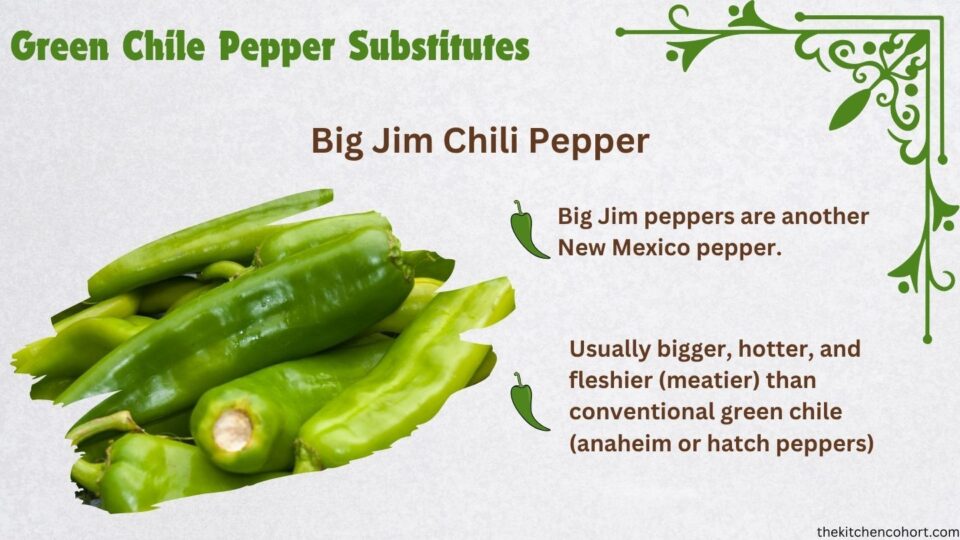
Big Jim is another popular green chile from New Mexico. They’re a bit bigger, hotter, and meatier than conventional anaheim peppers. They’re fairly popular as green chili peppers, especially in New Mexico cuisine and recipes. Their application generally involves roasting these peppers, though the cultivar is also available as fresh green chili.
If allowed to ripen, Big Jim chili peppers will turn to red. However, they’re harvested green and are thus suitable options as substitutes for green chilies. While hotter than conventional anaheim peppers, Big Jims are generally rated medium on the Scoville Scale.
4. Indian Green Chile
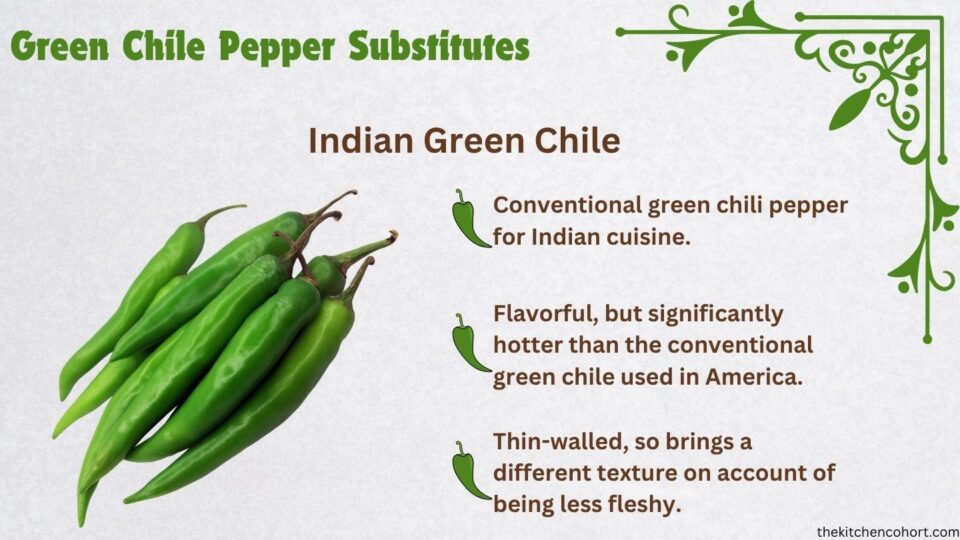
Famed for its use in Indian cuisine, the hot and spicy Indian green chile or Indian green chili pepper can be a good substitute for green chilies. The most popular Indian variant for green chili pepper is called Jwala, though the cultivar name isn’t used as often.
Indian green chile is not meaty and has thin walls, which would be somewhat similar to a cayenne pepper. The rating on Scoville Scale is generally around 20,000 SHU, making it hotter than conventional green anaheim chili peppers available in the USA.
So, if you’re making this substitution, be prepared to either reduce the amount of chili used, or for a much hotter recipe! There can also be a slight change in texture of the recipe, owing to the thin walls of the Indian green chile.
5. Green Cayenne Pepper
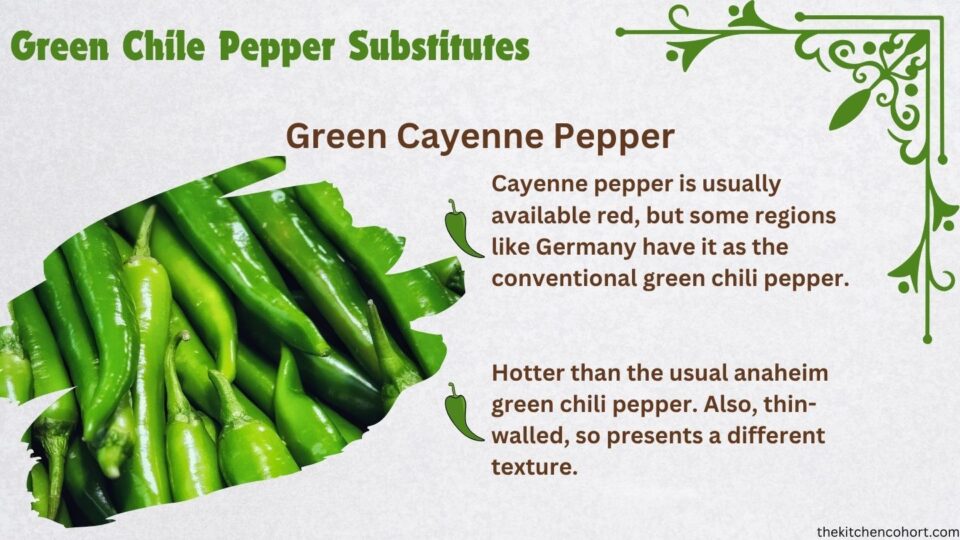
We know cayenne chili peppers best in their red hot and spicy look. However, some variants are sold in their green look as well. This seems to be largely the case in European nations like Germany and Netherlands.
Green cayenne chile peppers can be long, but aren’t meaty and have thin walls. They also fall squarely in the “hot” category of the Scoville scale, ranging at 30,000 to 50,000 SHU. So, if your chili pepper of choice is green cayenne, and you don’t want a very hot recipe, it’s best to moderate the use of this chile.
As such, it can work as a green chile substitute, but with the caveat of this being less meaty, and a whole lot hotter.
6. Serrano Pepper
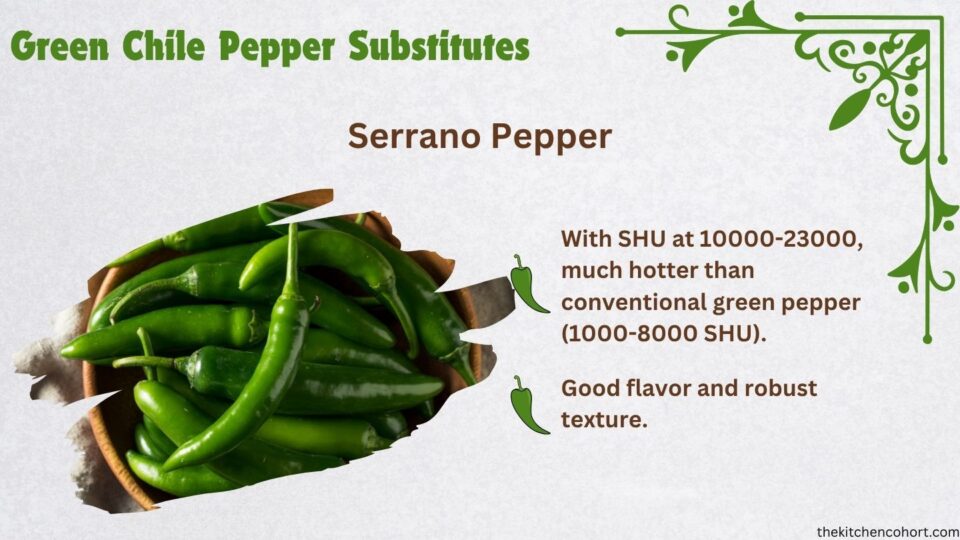
Serrano peppers can be your choice of green chilies. They are worthy to be used all by themselves, but also work as a green chile alternative. Serrano peppers are somewhat meaty with a robust fleshy texture. That brings them closer to conventional green chilies like anaheim peppers, especially where texture is concerned.
However, what doesn’t quite match as well is heat. Serrano peppers are notably hotter, going in the range of 10,000 to 23000 SHU. This is, of course, notably hotter than the conventional green chile that lies in the 1000-8000 SHU range.
Some adjustments will be necessary for such a substitution. However, if you enjoy the recipe with a bit more spice, Serrano peppers are just the right fit.
7. Green Fresno Peppers
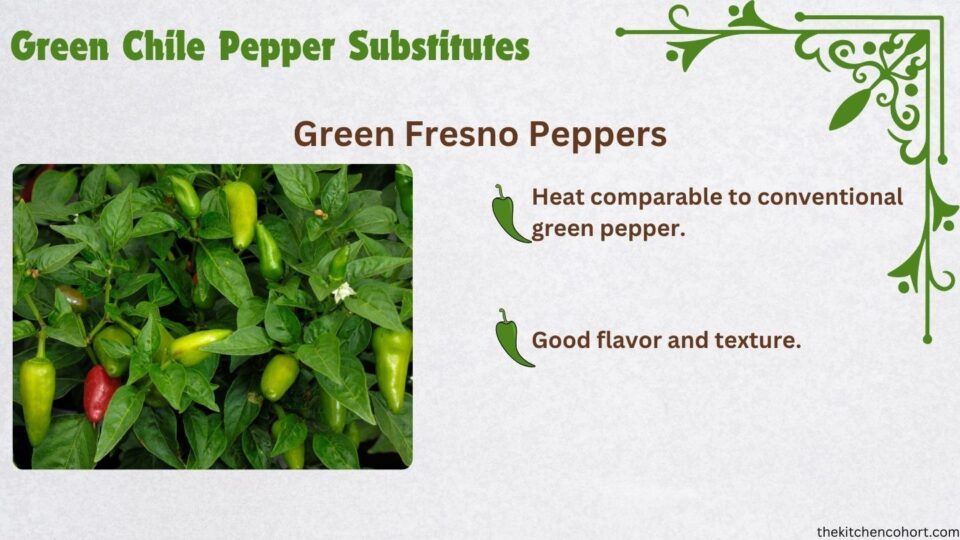
We know Fresno peppers for the beautiful red chilies that they are. Yet, before they turn red, these chile peppers spend a good amount of time as flavorful green chili peppers as well. And they are flavorful enough to work as substitutes for green chilies.
Notably, fresno peppers lie in the SHU range of 2500 to 10000 SHU. This makes them hotter than the average anaheim pepper, but they could be more in line with the spiciness of the Hatch green peppers. Green fresno peppers are also meaty enough to not take the texture far away from the original recipe. But there is bound to be a slight change in taste.
Fresno peppers have a fruity and spicy flavor that’s more similar to jalapenos. On the other hand, anaheim peppers are milder with more pronounced sweet notes.
To be clear, I’m listing this difference in taste because green Fresno peppers work so much better as a substitute than several other options on this list.
8. Poblano Pepper
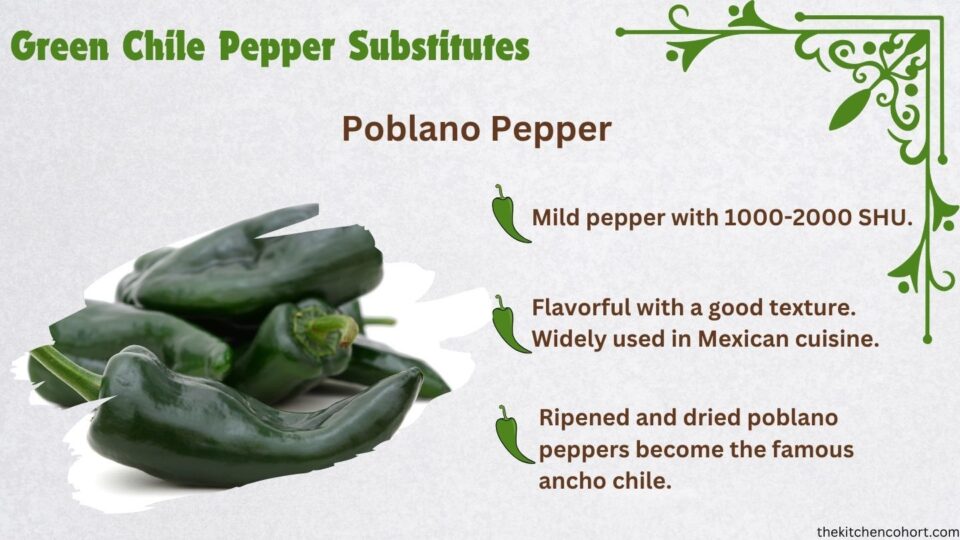
The mild and flavorful poblano pepper is an amazing replacement for green chilies in most recipes. The dark green color with a rich, earthy flavor is extremely pleasant for the taste buds. Plus, these peppers are fairly meaty, so they work rather well where texture is concerned as well.
Poblano peppers are milder than conventional green chili peppers, hitting just around 1000 to 2000 on the Scoville scale. These are an excellent choice when you want less spice for your recipe.
When dried, poblano chile turns into ancho chile, which is another famous chile and much liked in Mexican cuisine. Theoretically, the mild ancho chile can work as a green chili pepper substitute for several recipes, but it’s much better used for sauces where its color and flavors can shine.
The poblano pepper, though, can work as a substitute for green chili peppers, while also showing off its own flavorful side.
9. Jalapeno Pepper
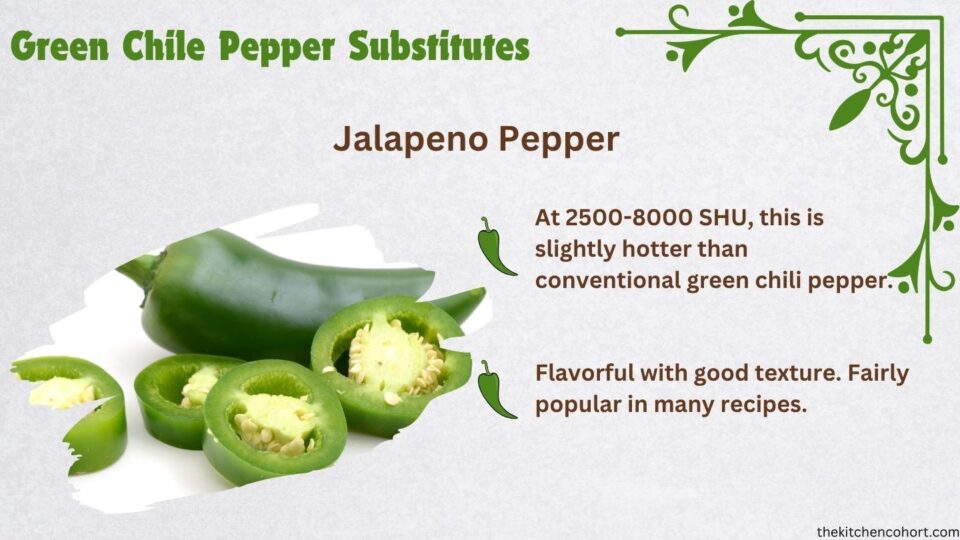
The famous jalapeno pepper can be a worthy substitute for regular green chiles, especially when you’re okay with the increased spiciness. Jalapeno peppers range from 2500 to 8000 SHU, making them notably hotter than conventional green chili at 1000-8000 SHU range. Note, that while the ranges appear similar, the jalapeno pepper is more likely to be on the higher side of the spiciness than conventional green chile.
Of course, a difference in flavors is to be expected with the substitution, but it’s not entirely foreign to the conventional flavors of the green chile.
10. Banana Pepper
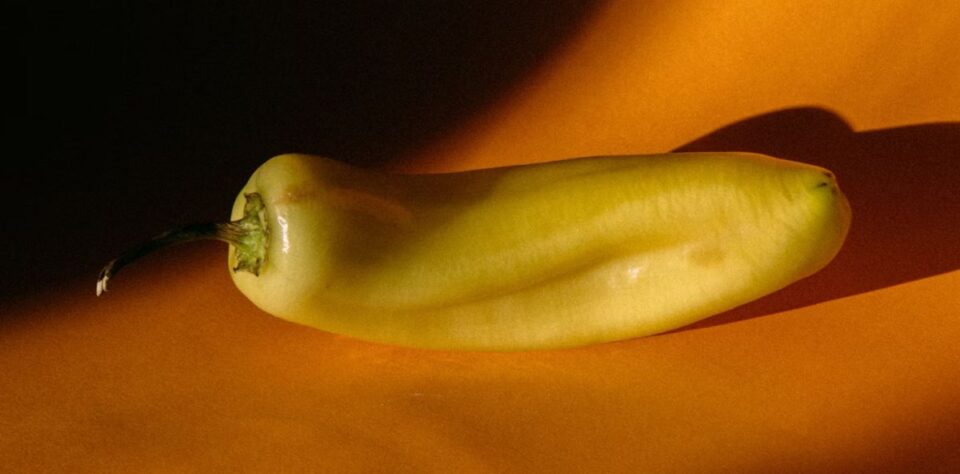
Banana peppers are excellent non-spicy substitutes for green chili peppers. They aren’t exactly without heat, but with just 0-500 on the Scoville scale, the spiciness is pretty mild. There is also a slight difference in texture as the banana peppers aren’t as thick walled and fleshy,
Yet, thanks to the low heat and sweet undertones of flavor, banana pepper lends itself rather well to most recipes, especially when you don’t want the recipes to get too spicy.
11. Bell Pepper
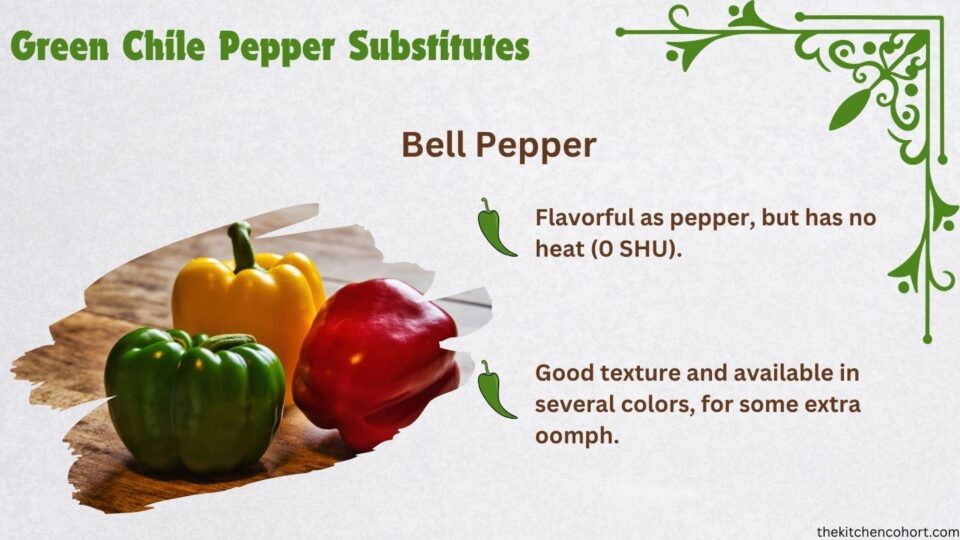
Bell peppers are an excellent choice when you want an absolutely non-spicy pick as a substitute for green chilies. Incidentally, bell peppers are the only members of the biological genus Capsicum that produce no capsaicin, which is the chemical responsible for the feeling of pungency, heat, and spiciness in chili peppers.
As such, these peppers have the lowest score on the Scoville scale. Despite lacking in heat, they do maintain the flavors associated with chili peppers, along with sweet undertones. As such, they can work fairly well as replacements for green chilies.
Green bell peppers are the most recognized and common form of this variety and would feel almost natural when used to substitute green chili peppers. However, bell peppers are available in a range of colors, and they can all work for the substitution. Perhaps experimenting with colors can be an option, should you choose to go this route!
12. Red Chili Peppers Or Hot Sauces – Substitutes Where Only Heat Is Required
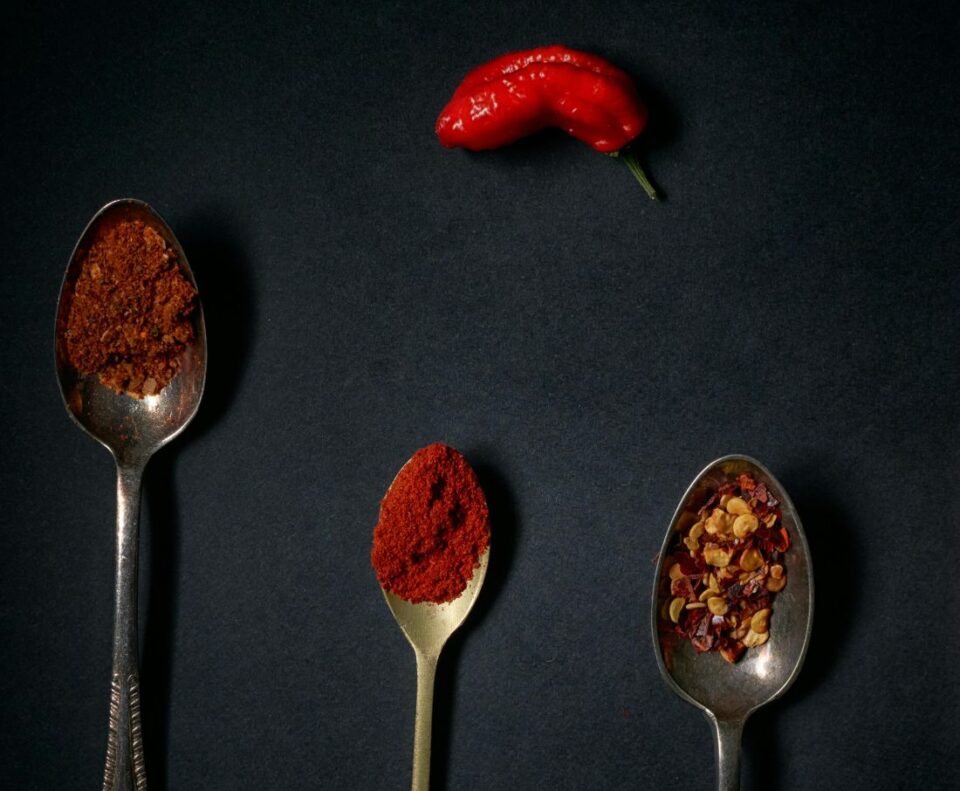
So far, when picking substitutes, we’ve considered several factors like flavors, texture, heat, color, availability, etc. But, what if you simply want a substitute to manage the heat of a recipe and are less concerned about the color or texture?
Well, that opens up a whole new world of possibilities! Go wild!
You can use red chili peppers or their substitutes of your choice, hot sauces, chili powder, and perhaps even black pepper.
The point is, there are pretty much countless choices if all you want is to add some heat to a recipe. And it’s rather easy to make use of that opportunity!
13. No-Nightshade Substitutes For Green Peppers
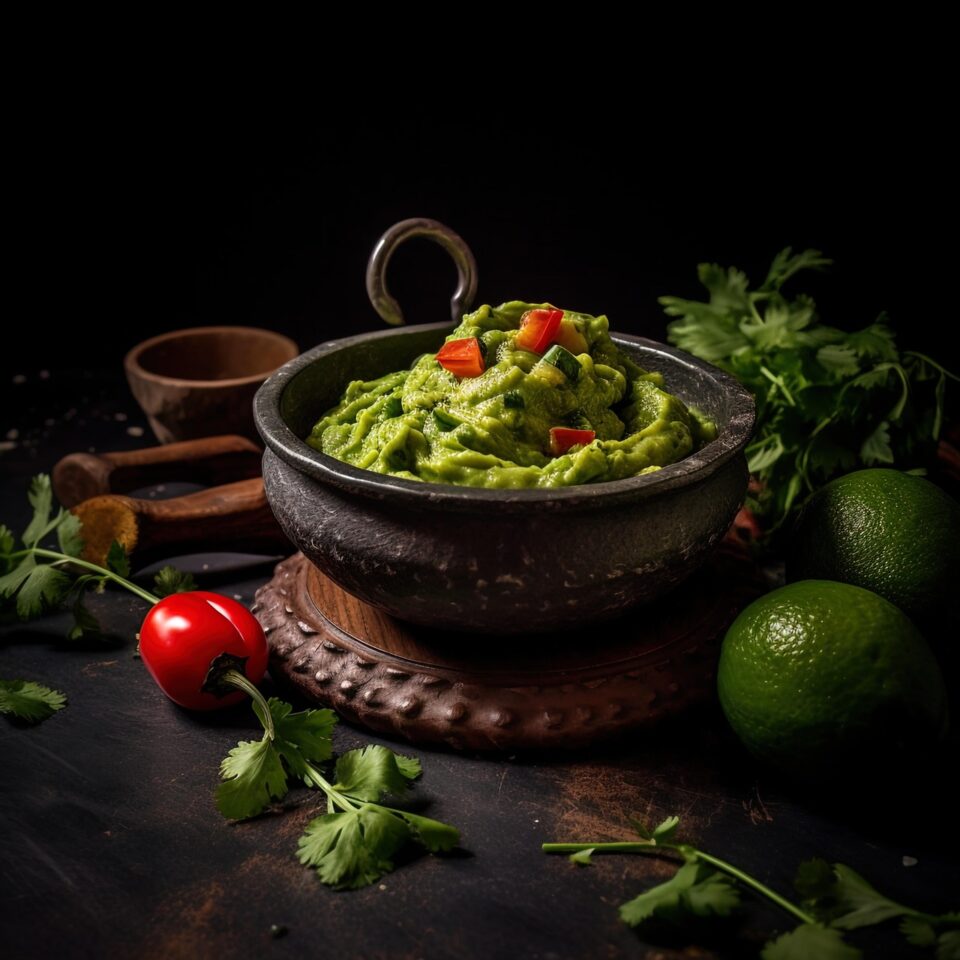
So far, all substitutes we’ve discussed fall into the broader nightshade family of plants, and that’s only natural considering that chili peppers are fairly unique and pretty much all of them fall into the nightshade family.
But, what if it’s important for someone to avoid nightshades? This could be due to a sensitivity, dietary requirements, or several other reasons.
The solution for this usually comes in two parts. One is a vegetable or other food that provides a texture similar to chile. The other is an ingredient that brings heat and spiciness to the food. Of course, if it’s just the heat and spiciness that’s desirable, you can always focus on the latter.
With these conditions in mind, the vegetables or foods that can be used for texture are:
- Cucumber
- Squash
- Zucchini
For the addition of heat, the following ingredients can be considered:
- Black pepper (despite the name, it comes from peppercorn, not a nightshade)
- Horseradish (paste or dried-grated)
- Wasabi (excellent in heat, but very expensive)
Where suitable, stronger flavored options like mustard seeds or even English mustard can be used for heat or a spicy touch for the recipe.
Of course, these combinations won’t create the unique flavors of peppers, but they’re excellent ingredients, and can work as a wonderful no-nightshade substitute for green peppers.
Some Key Aspects Related To The Discussion For Green Chile Substitution
Clarifying Chile, Chili, Chilli, And Chilies
If you look at these similarly spelled and pronounced words, it’s only natural to feel confused about their meaning and usage. And let’s be honest, the way they’re used is confusing. The distinction between many of these terms isn’t formal and can vary by region, context, and countries.
Here’s a quick overview. This is, of course, not meant to be educational or exhaustive, but just as a quick reference.
Chile usually refers to the plant, or the pepper that it produces. So, a green chile or poblano chile is acceptable. In some regions of New Mexico, chile might also refer to the stew that’s usually called chili in most other regions. Just to be clear, Chile is also the name of a country in South America, but that’s not relevant to our current discussion.
Chili generally refers to a stew, dish, or even the spice blend used to make chili. It can also refer to the peppers, but the phrase generally used becomes chili pepper. So, a green chili pepper, anaheim chili pepper, etc. are acceptable uses.
Chilli is a term used for the chili pepper in the UK and several other countries.
Chilies is simply a plural form for chilli and chili. The term usually applies to multiple chili peppers.
As I said, it’s very confusing and sort of weird because the terms often end up being interchanged in use anyway. Personally, I’m all in favor of going with the flow. As long as the context is clear, there is little benefit in fretting about spellings.
Managing Chile Heat By Deseeding
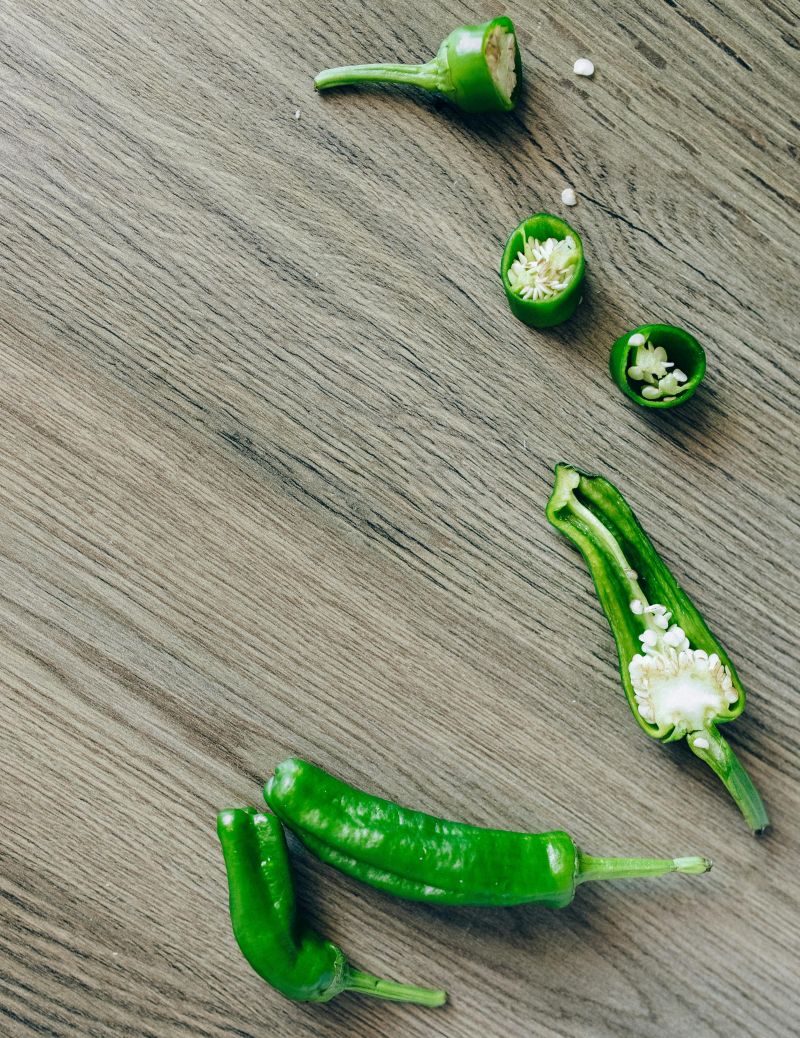
Here’s a situation – I’m working with chili peppers, but would like to reduce the heat a bit. This can also be handy in our substitution scenario, where one picks the chili pepper of preference, but would like to manage how hot it is in the recipe.
One simple way to handle this is by cutting the chili pepper and removing the seeds. The seeds are a big carrier of the heat a chile carries, so removing the seeds helps reduce how spicy the peppers are.
There is, of course, a touch of customization that can be possible here – choosing to remove only some seeds, rather than entirely deseeding the chile. That way, there’s room to slightly manage how hot the pepper is.
It’s worth remembering that removing the seeds makes the chili less hot. It doesn’t mean that the chili pepper is no longer hot or spicy. So, while deseeding does help manage the heat a bit, it isn’t an absolute method for managing chile heat.
A Checklist For Picking Green Chili Pepper Substitutes
Picking the best substitutes for green chilies can be fairly easy, considering there are a whole lot of options available. So, the choice often comes down to picking the heat and texture you prefer.
Many alternatives to the conventional green chile have thin walls, so the texture doesn’t offer the same crunch. These include green cayenne pepper and Indian green peppers. Incidentally, both these options are hotter than the usual green chile we know.
If you prefer a similar or higher heat while maintaining the texture, consider picking jalapeno peppers, green Fresno pepper, or serrano peppers. Technically, serrano is thin-walled too, but it’s still better than cayenne peppers in this scenario.
In case the choice is to go lower on heat while maintaining texture, the options include bell peppers, banana peppers, and poblano peppers.
Those who want a no-nightshade substitute for green chilies can consider the combination of a food like cucumber or sliced zucchini, with the combination of black peppercorn or horseradish to provide the heat.

